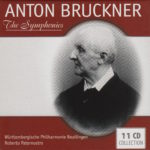 This morning’s conductor of Anton Bruckner’s Symphony No. 8 in C Minor (WAB 108), nicknamed “The Apocalyptic,” although I don’t know why, is Vienna-born Roberto Paternostro (1957?-).
This morning’s conductor of Anton Bruckner’s Symphony No. 8 in C Minor (WAB 108), nicknamed “The Apocalyptic,” although I don’t know why, is Vienna-born Roberto Paternostro (1957?-).
I first heard the mysterious Mr. Paternostro (the box set contains zero information about him…and there’s scant info about him online) on Day 11, when he interpreted Symphony No. 1.
Then again on Day 27, Symphony No. 2.
Then again on Day 43, Symphony No. 3.
Then again on Day 59, Symphony NO. 4.
 Then again on Day 75, Symphony No. 5.
Then again on Day 75, Symphony No. 5.
Then again on Day 91, Symphony No. 6.
Then again, most recently, on Day 107, Symphony No. 7.
Today is the eighth time I’m hearing Maestro Paternostro interpret a Bruckner symphony.
If you want to know what I thought of those previous symphonies, take a peek. Let your mouse do the clicking. Otherwise, here are the facts about today’s recording:
 Bruckner’s Symphony No. 8 in C Minor (WAB 108), composed 1884-1890
Bruckner’s Symphony No. 8 in C Minor (WAB 108), composed 1884-1890
Roberto Paternostro conducts
Paternostro used the “1890 Version,” according to the CD sleeve, most likely edited by Nowak
Wurttembergische Philharmonie Reutlingen plays
The symphony clocks in at hefty 85:30 (Yikes!)
This was recorded live at Basilika Weingarten, Germany, on July 15, 2000
Paternostro was 45 when he conducted it
Bruckner was 66 when he finished composing it
This recording was released on the SWR/Membran label
Bruckner wrote his symphonies in four parts. The time breakdown of this one (Symphony No. 8 in C Minor, 1890 Version), from this particular conductor (Paternostro) and this particular orchestra (Wurttembergische Philharmonie Reutlingen) is as follows:
I. Allegro moderato…………………………………………………………………………….17:13
II. Scherzo. Allegro moderato…………………………………………………………….14:24
II. Adagio. Feierlich langsam; aber nicht schleppend……………………….28:37
IV. Finale. Feierlich, nicht schnell……………………………………………………….25:18
Total running time: 85:30 (over two CDs: CD 1 is 31:36 , CD 2 is 53:54)
Of the 1890 Version, its entry on Wikipedia tells us this:
Some scholars such as Deryck Cooke and Robert Haas have suggested that the 1890 revision was the product of Bruckner’s insecurity and pressure from his colleagues such as Josef Schalk: Cooke even referred to it as the “Bruckner-Schalk revision”. Against this Leopold Nowak has pointed out that there is no evidence of any handwriting other than Bruckner’s own in the 1890 manuscript. According to the testimony of Bruckner’s friends and associates the composer was extremely resistant to outside interference.
The scoring of the 1890 version is fuller and more grandiloquent than the 1887 version, with subtler textures and harmonies in the woodwind in particular, allowed for by the increased size of this section of the orchestra. It was published in 1955 in an edition edited by Leopold Nowak.
And now for my subjective assessment:
My Rating:
Recording quality: 3
Overall musicianship: 3
CD liner notes: 0 (totally unacceptable)
How does this make me feel: 2
Paternostro and Wurttembergische Philharmonie Reutlingen turned in an ass-numbing performance of Bruckner’s Eighth. I mean, seriously, did he really need 85:30 to tell the tale – any more than Maazel needed 86:05? Any symphony that approaches an hour and a half had better be freaking brilliant. Or performed by musicians sent from God on high and imbued with all the facets and allure of the star-filled heavens.
Unfortunately, the former is true: Bruckner’s Eighth is brilliant…but this wasn’t performed by musicians sent from God on high and imbued with all the facets and allure of the star-filled heavens.
Since this is only about a minute less than Maazel’s bloated performance (from Day 121), I’d say this and Maazel’s interpretation are in a dead heat for the Ass Number Award.
The thing that bugs me the most about this box set, in general, is the lack of liner notes, as well as the total lack of information about the record label, the symphony, and the conductor. To find the name of the record label that produced this, I had to search high and low – and eventually see it on the back of the box, down at the bottom. It’s like they’re trying to hide the fact they released this.
The main thing that bugged me about this performance, in particular, is that it sounds like it was recorded with some of the instruments in a shoe box in the hall closet. It has a tiny sound, a small sound.
Or, maybe this is a better way to put it: The musicians sound like they’re playing with straight jackets on. Restrained. Reserved. Withdrawn.
In parts where I’d expect unbridled enthusiasm – all-out, triumphant exhuberance – I get a small sound that makes me feel like I’ve been sucking on lemons, all puckered. Like a big sphincter. (Which isn’t really that far off. I’ve been called an ass before. Many times.)
I was fooled by this recording. At first, anyway. I thought the Allegro held great promise. The French horns were so pretty, so delicate, so warm (around the 6-minute mark). I was intrigued.
But the brass instruments in the Scherzo sounded like toys, like the orchestra was performing on kazoos. Just…tiny.
And the Finale had that same puckered sound, like the musicians were being held back. And were playing with tiny instruments without the power to rise above, to express reckless abandon, joy.
Obviously, this is just my opinion.
Your mileage may vary.
